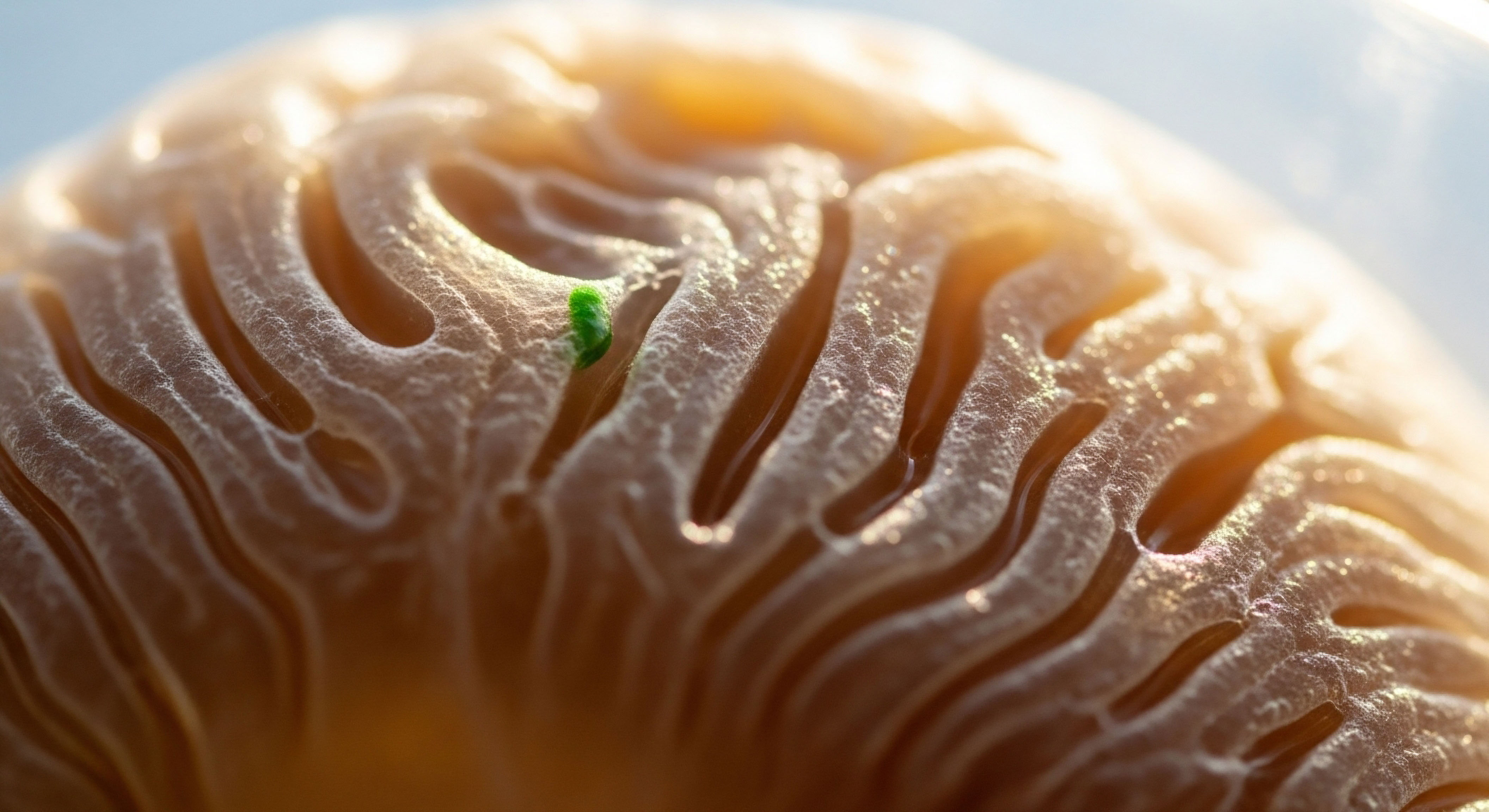

Fundamentals

The Rhythm of Your Life
You feel it long before you can name it. It is the bone-deep weariness that persists after a full night’s sleep, the mental fog that clouds your mornings, or the frustrating experience of lying awake, staring at the ceiling while your mind races. These sensations are more than just fatigue.
They are signals from your body that its internal clock, the fundamental rhythm that governs your energy, mood, and vitality, has been disturbed. This internal pacemaker is your circadian rhythm, a sophisticated biological system orchestrating a 24-hour cycle of physiological processes. Your ability to fall asleep, wake up refreshed, and perform at your peak is deeply tied to the precise, predictable function of this internal clock.
This rhythm is anchored within a specific region of your brain called the suprachiasmatic nucleus (SCN), located in the hypothalamus. The SCN functions as the master conductor of your biological orchestra. It receives direct input from your eyes, responding to the presence or absence of light to synchronize your internal world with the external day-night cycle.
When light fades, the SCN signals the pineal gland to release melatonin, the hormone that prepares your body for sleep. As dawn approaches, it cues the adrenal glands to produce cortisol, a steroid hormone that promotes wakefulness and alertness. This elegant interplay of hormones is the foundation of a healthy sleep-wake cycle.
Your body’s internal clock dictates the timing of nearly every biological process, from hormone release to cellular repair.
Disruptions to this system, whether from chronic stress, irregular schedules, or the natural process of aging, create a cascade of consequences. The communication breaks down. Melatonin release may become blunted or delayed, making it difficult to fall asleep.
Cortisol levels might remain elevated at night, contributing to anxiety and sleeplessness, or fail to rise sufficiently in the morning, leading to persistent grogginess. Your body is sending out distress signals, but the messages are getting lost. This is where the concept of targeted biological intervention becomes relevant.

Peptides the Body’s Native Messengers
Your body communicates with itself using a language of precise molecular signals. Peptides are a vital part of this language. They are short chains of amino acids, the building blocks of proteins, that function as highly specific messengers. They travel through the bloodstream and bind to receptors on cell surfaces, instructing them to perform specific tasks.
For instance, a peptide might tell a pituitary cell to release a hormone, a skin cell to produce collagen, or a neuron to modulate its firing rate. They are fundamental regulators of a vast array of bodily functions, including growth, metabolism, inflammation, and, critically, sleep.
Peptide therapies utilize bioidentical or synthetic versions of these natural signaling molecules. The goal is to restore clear communication within a biological system that has become dysfunctional. When the body’s own production of a key peptide wanes or its signaling becomes confused, introducing a targeted peptide can re-establish the proper instructions.
This approach works with the body’s innate systems, aiming to recalibrate function rather than introducing a foreign substance to suppress a symptom. In the context of circadian rhythm, specific peptides can directly or indirectly support the body’s sleep-regulating machinery, helping to restore the natural cadence of rest and wakefulness.


Intermediate

Recalibrating the Master Clock with Specific Peptides
When the circadian rhythm is disrupted, a targeted approach is required to restore its function. Peptide therapies offer several distinct pathways to support the body’s sleep-wake cycle, each with a unique mechanism of action. These protocols are designed to work with your physiology, enhancing the natural processes that govern restorative sleep.
The selection of a specific peptide or combination of peptides depends on the underlying nature of the circadian disturbance, whether it stems from a deficiency in deep sleep, a dysregulated hormonal cascade, or a blunted melatonin response.
Targeted peptides can act directly on sleep centers in the brain or indirectly by restoring hormonal cycles that are crucial for deep sleep.
Two primary categories of peptides are utilized for circadian support ∞ those that directly influence sleep architecture and those that optimize the hormonal environment for sleep. Understanding the distinction is key to appreciating how these therapies are applied in a clinical setting to address individual needs and restore biological harmony.

Direct Sleep Architecture Modulation Delta Sleep-Inducing Peptide
Delta Sleep-Inducing Peptide (DSIP) is a naturally occurring neuropeptide with a primary role in the regulation of sleep. It was first isolated from the cerebral venous blood of rabbits in a state of deep sleep, and its name reflects its function.
DSIP readily crosses the blood-brain barrier and exerts its effects on structures in the brainstem and hypothalamus that are central to sleep regulation. Its primary mechanism is the promotion of delta-wave sleep, which is the deepest and most physically restorative phase of non-REM sleep. It is during this stage that the body undertakes critical repair processes, consolidates memories, and clears metabolic waste from the brain.
Individuals with disrupted circadian rhythms often exhibit a marked reduction in delta sleep. They may get a full eight hours of sleep but wake up feeling unrefreshed because they are not spending enough time in this vital stage. DSIP administration, typically via a subcutaneous injection before bedtime, can help normalize sleep architecture.
It helps decrease sleep onset latency, the time it takes to fall asleep, and increases the percentage of time spent in deep sleep. This direct modulation of the sleep cycle can help re-anchor a drifting circadian rhythm, making it a valuable tool for addressing conditions like insomnia, jet lag, and sleep disturbances related to shift work.

Indirect Circadian Support through Growth Hormone Optimization
Another sophisticated strategy involves restoring the powerful connection between sleep and the endocrine system, specifically the release of Growth Hormone (GH). The majority of your daily GH secretion occurs during the first few hours of sleep, specifically during delta-wave sleep. This hormone is a master regulator of cellular repair, metabolism, and body composition.
A healthy, robust pulse of GH at night is a hallmark of youthful physiology and restorative sleep. As we age, the amplitude of this nocturnal GH pulse naturally declines, which can contribute to poorer sleep quality and a less resilient circadian rhythm.
Peptide therapies can powerfully and safely restore this nocturnal GH pulse. This is typically achieved with a synergistic combination of two types of peptides:
- Growth Hormone-Releasing Hormone (GHRH) Analogs ∞ Peptides like Sermorelin and Tesamorelin are analogs of the body’s own GHRH. They work by stimulating the GHRH receptors in the pituitary gland, prompting it to produce and release GH.
- Growth Hormone Secretagogues (GHS) ∞ Peptides like Ipamorelin and Hexarelin mimic the hormone ghrelin and act on a different receptor in the pituitary (the GHS-R1a receptor). This action also stimulates GH release and, importantly, Ipamorelin does so without significantly affecting cortisol or prolactin levels, making it highly selective.
The combination of a GHRH analog with a GHS, such as CJC-1295 with Ipamorelin, creates a powerful synergistic effect, leading to a significant and sustained release of GH that mimics the body’s natural nocturnal pulse. By restoring this key hormonal event, these peptides deepen slow-wave sleep, enhance physical recovery, and reinforce the body’s natural circadian timing. The body learns to associate deep sleep with this vital restorative process once again.

Comparative Mechanisms of Sleep-Modulating Peptides
| Peptide Protocol | Primary Mechanism of Action | Effect on Circadian Rhythm | Primary Clinical Application |
|---|---|---|---|
| DSIP | Directly promotes delta-wave (deep) sleep activity in the brain. | Directly resets sleep architecture; useful for insomnia and jet lag. | Normalizing sleep patterns and improving sleep quality. |
| CJC-1295 / Ipamorelin | Stimulates a natural, pulsatile release of Growth Hormone from the pituitary gland. | Indirectly reinforces rhythm by enhancing deep sleep and associated hormonal cycles. | Improving sleep depth, physical recovery, and anti-aging protocols. |
| Epitalon | Regulates pineal gland function and promotes endogenous melatonin production. | Directly supports the primary sleep-initiating hormone signal. | Restoring age-related decline in melatonin and circadian function. |

What Is the Role of the Pineal Gland in Sleep Regulation?
The pineal gland, a small endocrine gland located deep in the brain, is a central player in circadian regulation. Its primary function is to produce and secrete melatonin. The synthesis of melatonin is tightly controlled by the SCN and is inhibited by light.
As darkness falls, the SCN signals the pineal gland to begin melatonin production, which then circulates throughout the body, lowering body temperature and inducing drowsiness to prepare for sleep. The peptide Epitalon is a synthetic analog of a natural pineal peptide called Epithalamin.
Research suggests that Epitalon can help regulate the function of the pineal gland, potentially restoring a more youthful pattern of melatonin release. This makes it a therapeutic option for individuals whose circadian disruption is linked to age-related decline in pineal function and melatonin output.


Academic

Molecular Mechanisms of Peptide-Mediated Circadian Restoration
The capacity of targeted peptides to restore circadian function is grounded in their interaction with the core molecular machinery of the body’s timekeeping systems. The canonical circadian clock operates within nearly every cell and is governed by a complex set of transcriptional-translational feedback loops involving specific “clock genes” such as CLOCK, BMAL1, PER, and CRY.
The proteins encoded by these genes regulate their own expression over a roughly 24-hour period, creating a stable, oscillating rhythm that dictates cellular behavior. The master clock in the suprachiasmatic nucleus (SCN) synchronizes these peripheral clocks via neural and endocrine signals. Peptides can intervene at multiple levels of this intricate hierarchy, from the master clock itself to the peripheral cellular oscillators.
Recent research has demonstrated that certain peptides can directly influence the expression of these core clock genes. For example, studies on tetrapeptide matrikines in human keratinocytes and fibroblasts found that these small peptides could effectively synchronize cellular rhythms. This was observed through the rhythmic expression of the PER2 gene.
This finding is significant because it shows a direct link between an external peptide signal and the fundamental gears of the cellular clock. The implication is that certain peptides may act as powerful chronobiotic agents, capable of resetting cellular clocks that have become desynchronized due to aging or environmental stressors. This action at the cellular level provides a foundational mechanism for the system-wide improvements in circadian rhythm observed clinically.

The Hypothalamic-Pituitary Axis and Sleep Neurobiology
The hypothalamus is the command center for both sleep and endocrine function, making it a critical nexus for peptide action. It houses the SCN master clock and also produces the releasing hormones that govern the pituitary gland. Peptides like DSIP exert their influence within this region.
DSIP is understood to modulate the activity of various neurotransmitter systems, including GABAergic, serotonergic, and glutamatergic pathways, which collectively control the transitions between sleep and wakefulness. Its ability to promote delta sleep is likely mediated by its influence on thalamocortical oscillations, pushing brain activity towards the slow, synchronized waves characteristic of deep sleep.
Simultaneously, the growth hormone secretagogues like Sermorelin and CJC-1295/Ipamorelin directly target the hypothalamic-pituitary (HP) component of the HPA and HPG axes. They restore the pulsatile secretion of Growth Hormone (GH), a process that is tightly coupled to sleep architecture.
The nocturnal GH surge is not merely a consequence of sleep; it is an integral part of the restorative process that sleep facilitates. This surge is driven by a complex interplay between Growth Hormone-Releasing Hormone (GHRH), somatostatin (which inhibits GH release), and ghrelin.
By stimulating the GHRH and ghrelin pathways, these peptides bypass age-related declines in endogenous signaling, reinstating a robust GH pulse that enhances slow-wave sleep depth and duration. This, in turn, helps to stabilize the entire sleep-wake cycle and reinforce circadian stability.

Key Peptides and Their Locus of Action in the Neuroendocrine System
| Peptide | Primary Target Site | Molecular/Cellular Action | System-Level Outcome |
|---|---|---|---|
| DSIP | Brainstem, Hypothalamus, Thalamus | Modulates GABAergic and other neurotransmitter systems; promotes thalamocortical delta waves. | Increased deep sleep duration and improved sleep architecture. |
| CJC-1295 / Ipamorelin | Anterior Pituitary Gland | Stimulates GHRH and ghrelin (GHS-R1a) receptors to increase GH synthesis and release. | Restoration of nocturnal GH pulse, enhancing slow-wave sleep and physical repair. |
| Epitalon | Pineal Gland | Interacts with pinealocytes to regulate telomerase activity and normalize melatonin production. | Synchronization of the sleep-wake cycle via the melatonin pathway. |
| PT-141 (Bremelanotide) | Hypothalamus (Melanocortin Receptors) | Activates MC3R/MC4R, which are involved in energy homeostasis and inflammation. | Indirect influence on circadian rhythm through modulation of hypothalamic functions. |

How Do Melanocortin Receptors Influence Circadian Function?
The melanocortin system, primarily mediated by receptors like MC3R and MC4R in the brain, adds another layer of complexity. While peptides like PT-141 (Bremelanotide) are primarily known for their effects on sexual arousal, their site of action in the hypothalamus means they can influence other homeostatic processes, including energy balance and inflammation, which are themselves tightly regulated by the circadian clock.
The melanocortin system interacts with neuropeptide systems that regulate appetite and energy expenditure, such as NPY and POMC neurons. These same neurons are known to provide input to the SCN and other sleep-regulating centers. Therefore, modulation of the melanocortin system could have secondary, indirect effects on circadian timing by altering the metabolic and inflammatory signals that the master clock receives and interprets.
This highlights the interconnectedness of these regulatory systems, where a peptide targeted at one function can have cascading effects on others.
The body’s regulatory networks are deeply interconnected; influencing one hormonal or neuropeptide system can create cascading effects on others, including the circadian clock.
The academic exploration of these peptides reveals that their ability to restore circadian rhythm is not a single action but a multi-faceted process. They can act directly on the molecular clockworks within our cells, modulate the activity of sleep-promoting brain regions, and restore the critical endocrine signals that define the 24-hour cycle of rest and activity.
This systems-level approach, which acknowledges the profound integration of our neurological, endocrine, and cellular functions, is the future of personalized wellness and the key to understanding how we can truly restore the body’s fundamental rhythms.

References
- Sigalos, J. T. & Pastuszak, A. W. (2018). The Safety and Efficacy of Growth Hormone Secretagogues. Sexual Medicine Reviews, 6(1), 45 ∞ 53.
- Brown, M. Powner, M. B. & O’Neill, J. S. (2023). Tetrapeptide matrikines synchronize circadian rhythms and promote proliferation in human skin cells. British Journal of Dermatology, 189(1), 101 ∞ 103.
- Khavinson, V. K. Popovich, I. G. & Linkova, N. S. (2020). Peptides, Genome, and Aging. Gerontology, 66(2), 113-122.
- Graf, M. V. & Kastin, A. J. (1984). Delta-sleep-inducing peptide (DSIP) ∞ a review of its effects on sleep and wakefulness. Peptides, 5(4), 823-831.
- Schneider-Helmert, D. & Schoenenberger, G. A. (1983). Effects of DSIP in man. Multifunctional psychophysiological properties besides induction of natural sleep. Neuropsychobiology, 9(4), 197-206.
- Toth, L. A. & Krueger, J. M. (1988). Alteration of sleep in rabbits by human recombinant interleukin-1 and tumor necrosis factor. Journal of immunology, 140(9), 3103-3106.
- Weikel, J. C. de la Iglesia, H. O. & Daan, S. (2014). The role of the suprachiasmatic nucleus in the timing of sleep and wakefulness. Chronobiology international, 31(6), 704-717.
- Van Cauter, E. L’Hermite-Balériaux, M. Copinschi, G. & Refetoff, S. (1991). Pulsatile growth hormone secretion in normal man during the night ∞ the role of sleep. Journal of endocrinological investigation, 14(Suppl 4), 5-10.

Reflection

Your Biology Is Your Story
The information presented here offers a map, a detailed guide to the intricate biological pathways that govern your daily rhythm of energy and rest. This knowledge provides a new lens through which to view your own experiences. The persistent fatigue, the restless nights, the sense of being out of sync with your own life ∞ these are not personal failings.
They are data points in a larger story, the story of your unique biology communicating its needs. Understanding the roles of neuropeptides, hormonal pulses, and cellular clocks transforms the conversation from one of frustration to one of possibility.
This clinical science is the beginning of a new chapter in that story. It illuminates the path, showing how specific interventions can help restore the clear communication your body needs to function optimally. The ultimate goal is to move beyond simply managing symptoms and toward a state of true physiological harmony.
Your journey to reclaim vitality is a personal one, and it begins with the profound understanding that you have the capacity to work with your body’s innate intelligence to rebuild its fundamental rhythms from the inside out.



